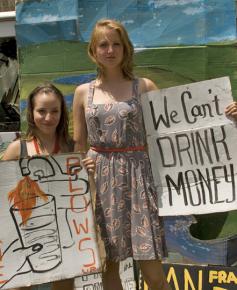People can’t drink natural gas
Natural gas fracking in West Texas is compounding the disastrous effects of a record-setting drought--but as reports, the industry is pushing for more.
FOR ROUGHLY the last decade, the U.S. has been experiencing a boom in natural gas production thanks to a drilling technique called hydraulic fracturing--or "fracking." The idea behind fracking is to break up shale formations by exploding the rock and injecting water, laden with sand and industrial chemicals, into the cracks left behind, then withdrawing the toxic mixture to release natural gas.
The process was developed in Texas, where the energy industry's long history of oil and gas production has led to loose regulations and business-friendly politicians. Texas is estimated to have the largest potential reserves of natural gas that can be obtained by tracking, and the boom hasn't slowed since it began.
The key ingredient in hydraulic fracturing is water--between 2 and 9 million gallons of water per well. In 2010, nearly 14 billion gallons of water were consumed by the natural gas industry in Texas, accounting for about 1 percent of the entire state's water consumption.
None of those billions of gallons of water will ever again be useful for human, animal or agricultural consumption. Some companies have developed a way to recycle some of the water from a fracked well for use in another well, but most of the industry doesn't bother.

Either way, 70 to 80 percent of the millions of gallons of water never comes back out of the ground. In a state that has repeatedly experienced record-breaking droughts in recent years, this appropriation and literal destruction of useable water is a crime.
IN BARNHART, Texas--which is roughly midway between El Paso and Dallas, in a region where long-term drought conditions are hitting the hardest--residents last month found their municipal water supply had run dry. The town of about 200 survived on bottled water for five days until a well abandoned at the turn of the last century was revived--it is producing, but the water must be boiled before it's used.
Since this incident, Barnhart has become famous as the first town to be sucked dry by the natural gas industry, but it certainly won't be the last. Just five miles away, in Mertzon, residents already fear their town will be next. Other places in the region need to have water trucked in from other locations to survive. The Texas Commission on Environmental Quality lists more than 30 other municipalities in Texas that are at risk of running out of water by the end of the year.
Across Texas, more than 300 towns and cities have implemented water rationing, and many more bar citizens from watering lawns or filling swimming pools. But while residents are subject to fines for using too much water, the gas industry is free to use as much as it wants. In Crocket County, adjacent to Barnhart, fracking uses up 25 percent of the county's water supply.
Industry mouthpieces insist that hydraulic fracturing isn't running towns dry--drought is. Such claims ignore the evidence that fracking is compounding the problem in the face of a devastating drought. But even setting that aside, what about the obvious connection of the energy industry to long-term worsening droughts--the result of prolonged use of fossil fuels at the root of climate change that is desertifying whole areas of the southwest United States?
The reality of climate change, with all its catastrophic consequences to come, is accepted science now, and the U.S. public is more and more concerned about the issue according to polls. Yet the energy industry, its promoters and the politicians who serve it keep insisting that the U.S. needs to produce more natural gas, whatever the environmental cost.
In an era of human-driven climate change and deadly oil wars, the oil executives, banksters, industry-controlled politicians and subservient media outlets feed us nonsense about how the solution lies in in "domestic energy security"--which requires increasingly fracked backyards, continent-spanning oil pipelines and the continuing destruction of the global ecosystem.
That's the narrative to justify placing greater importance on ensuring that gas wells keep pumping than water wells. And what is taking place in towns like Barnhart will come to other less drought-stricken areas.
As you would imagine in a state where the energy industry holds sway, regulations on fracking in Texas are little more than what the industry says is necessary. But they aren't much better anywhere else.
Industrial chemical pollution, toxic water, carcinogens and radiation are all byproducts of the fracking process. Common risks include gas seeping into groundwater; spent water not being properly contained, so it goes back into groundwater; toxic mud being dumped into streams and lakes; and methane and carcinogenic hydrocarbons vented into the air. Common symptoms of the many diseases and health conditions to result from fracking include nausea, rashes and nosebleeds. People in fracked areas fear higher incidents of asthma and cancer. And then there is the flammable water, dead plant and animal life, and the threat of more frequent earthquakes.
Against all this, the natural gas industry promises that fracking will create jobs. That might sound appealing in an economy where long-term unemployment is still high, but the jobs typically created by fracking don't necessarily go to local people. Plus, studies of states where the fracking bubble has already burst, like Louisiana, find that for every job created by fracking, more jobs are destroyed due to emigration from the community, loss of business, damage to agriculture and undermined property values.
The increasingly obvious outcome of the commitment to the energy industry to fracking is a world without water, without peace and without a future like anything human societies have ever encountered. Instead of focusing on producing more natural gas, oil and coal, any rational society would reverse course before more damage is done--to people and to our environment.


